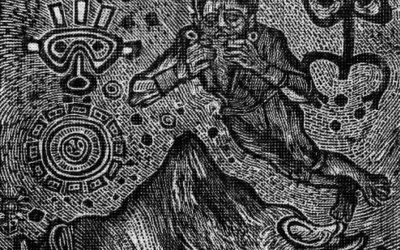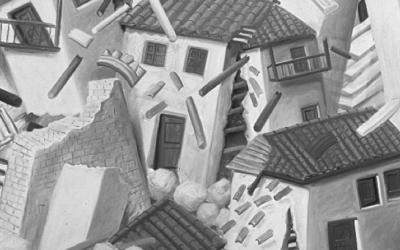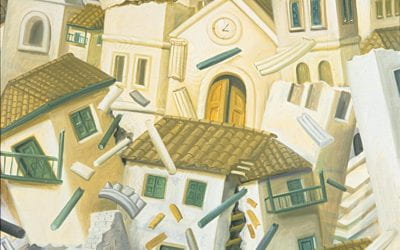Hurricane Stan and Social Suffering in Guatemala
The Social Course of Natural Disaster
In early October 2005, Hurricane Stan caused severe destruction in parts of Mexico, El Salvador, Honduras and Guatemala. This was just one month after Hurricane Katrina slammed the Gulf Shore of the southern United States. Since then, Hurricane Katrina has become a prime example of what medical anthropologists call social suffering – the clustering of social problems and the dangerous fact that institutional response can compound those problems. The response effort in New Orleans, as is well known, has been slow and largely inadequate. Not as many know of the devastation left in Stan’s wake. This storm affected people living on society’s margins and their difficult recovery process continues today.
Hurricane Stan was a regional disaster. The weather system dumped 20 inches of rain across Central America and southern Mexico. The torrential rains caused catastrophic flooding and mudslides. Farmland, homes, even entire communities were swept away. According to Red Cross estimates, the storm left more than a thousand people dead and affected more than two million lives. The devastation was compounded by earthquakes throughout the region, followed by a volcanic eruption in El Salvador on October 1. The United Nations Economic Commission estimated total damage at close to a billion dollars.
HURRICANE STAN IN HIGHLAND GUATEMALA
In Guatemala, Hurricane Stan caused more than 650 deaths, destroyed 35,000 homes and affected nearly 500,000 people. Damages totaled close to US$100 million. Hit particularly hard was Guatemala’s central highland region, a favorite destination for U.S. and European tourists. Travelers are drawn to market towns that dot the steep volcanic ridges rising steeply around Lake Atitlán. Kaqchikel, Tz’utujil, and K’iche’ Maya groups inhabit the towns.
The hurricane’s heavy rains triggered immense mudslides around the lake. On October 5, a half-mile river of mud rushed down the volcanic slopes above the town of Santiago Atitlán. Panabáj, a Tz’utujil Maya community on the outskirts of the town, was utterly destroyed. Mud and rocks swept away the homes and possessions of at least 5,000 people. More than 150 were killed; many bodies remain buried even today under tons of earth. Diego Esquina Mendoza, the mayor of Santiago Atitlán, declared the community a mass gravesite: “[Those buried by the mudslide] may never be rescued. Here they will stay buried, under five meters of mud. Panabáj is now a cemetery.”
THE POLITICAL ECONOMY OF VULNERABILITY
Natural disasters are never simply natural. They touch down in a particular context. Not all places are affected by disaster in the same way, because not all places have the same kind of infrastructure, economy and services. Several factors make people in highland Guatemala especially vulnerable in the case of a natural disaster.
Guatemala is a poor nation. Nearly 75 percent of the country’s 12.6 million residents live below the poverty line. Over half of the population lives in extreme poverty. In the 2006 United Nations Health Development Index ratings – a composite measure of health, education, and standard of living indicators – Guatemala ranks 118th out of 177 nations. Low literacy rates and unequal access to health care and other resources place the country closer to the Sudan and Haiti on this list than to nearby Costa Rica and Mexico. Crime rates have risen sharply in recent years. And government corruption and inefficacy perpetually hinder democratic reforms.
A pernicious racial divide further marginalizes people like the Tz’utujil Maya who live in Panabáj. Between 40 and 60 percent of Guatemala’s residents are indigenous. From conquest to colonialism to the recent genocidal civil war, there is a long history of exploitation and discrimination against the Maya. Indigenous communities have been marginalized at best, and terrorized, sometimes massacred, at worst. For example, in December 1990, 13 unarmed civilians were killed in a hail of gunfire while protesting at an army base near Panabáj. Amidst intense criticism from the media and international agencies, the Guatemalan government closed the base and withdrew all troops from Santiago Atitlán.
Peace Accords signed in 1996 ended the 36-year civil war. In the years since, international organizations, the state, and local communities have taken important steps toward reconciliation. But decades of violence are not easily overcome. Racism, fear, and distrust continue to divide Mayan and non-Mayan Guatemalans. And burdens of poverty and poor health weigh heavily on indigenous men, women and children. This combination of economic, sociopolitical, and institutional factors makes indigenous Guatemalans particularly vulnerable to a natural disaster like Hurricane Stan.
SOCIAL SUFFERING
Medical anthropologists have coined the term social suffering to emphasize the ways seemingly natural problems – earthquakes, storms, even illness – are also social problems. Political economic factors influence the ecology of suffering (who is affected and to what degree). In his book Infections and Inequalities, physician and medical anthropologist Paul Farmer documents the disproportionate impact of emergent infectious diseases such as tuberculosis and HIV/AIDS on poor people. Farmer contends that poverty itself acts as a pathogen, enabling the spread of disease and working against its effective treatment.
This approach emphasizes the clustering of human problems in local contexts. In their book Social Suffering, Arthur Kleinman, Veena Das, and Margaret Lock write, “Many of the same sources of breakdown, violence, emerging infectious diseases, and mental and social health problems are at work among poor populations worldwide.” This model of clustering runs against the common sense notion that individuals and communities suffer from only one or two major problems at a time. This is a powerful way to understand the broad social impact of Hurricane Stan in Guatemala. Hurricane Stan did not touch down in a vacuum. It touched down in a context of already existing social problems, and compounded many of those issues. The towns around Lake Atitlán already had insufficient access to potable water, limited health care services and undeveloped transportation routes in and out of the area. When flooding rains washed out bridges and roads, many residents were trapped without access to clean water or food. Hunger loomed. The colder dry season would begin in November. Without sufficient nutrition and shelter, and with sanitation and water systems damaged, disease susceptibility was a pressing concern. Hepatitis A, cholera, and respiratory infections, compounded by psychological stress and trauma, threatened the health of those who had survived the flooding rains and mudslides.
THE SOCIAL MEMORY OF SUFFERING
Social suffering draws our attention to the cultural and moral dimensions of what suffering means for people. Historians, anthropologists, and literary scholars have found that suffering in Latin America is often a wellspring for collective memories, shared forms of grieving and remembrance and group identity.
In the case of Guatemala, there is a well-documented literature on visions and dreams associated with experiences of suffering. Ted Fischer and Carol Hendrickson, anthropologists who have worked extensively in highland Guatemala, recount the narratives of indigenous people who survived a catastrophic 1976 earthquake. In Tecpán, a mostly Kaqchikel Maya town nearly leveled by the quake, people claim to have seen a pack of wolves in the streets the day before the disaster. “Wolves epitomize the wild, that part of the world that humans cannot control,” Fischer and Hendrickson write in their book, Tecpán Guatemala, “and in these stories their invasion of Tecpán symbolically foreshadowed the massive disruption of normative (‘cultural’) patterns of everyday life.” Today, the story helps residents explain the horrific disaster and maintain a collective historical memory of the suffering they experienced.
SOCIAL DIMENSIONS OF DISASTER RESPONSE
If suffering is a thoroughly social process, then so to are responses to suffering. Responses are influenced by societal and institutional factors. In the immediate aftermath of Hurricane Stan, there were quick and effective relief and fundraising efforts led by international organizations such as the Red Cross, Water for People, UNICEF, and Doctors without Borders. Anthropologists and other scholars who work in the region also helped in these efforts. Local governments provided food and water for neighboring towns. The US and other nations pledged relief aid. Victims of the storm sought shelter in schools, churches, and other public buildings or filled the homes of extended family members.
Government response was inadequate and in many ways ineffective. The Guatemalan military and public rescue workers were deployed to regions in need, bringing fresh water and supplies. Basic building materials for the construction of temporary shelters arrived in towns like Panabáj shortly after the mud had settled. The Guatemalan Congress authorized around US$135 million for relief and rebuilding projects. Yet bridges, roads, and water and sewage systems remained in shambles for months. Seven months after the disaster, less than one quarter of the appropriated funds had been utilized. Not one cent of the money allocated for housing had been spent. Today, many survivors continue to live in rudimentary constructions intended as temporary shelters, awaiting aid and additional resources promised by the state.
Remarkably, when military personnel showed up to assist with search and rescue efforts, many Tz’utujil Maya residents in Panabáj refused their help. They insisted on digging through the mud for survivors themselves. Their refusal was a form of protest and historical remembering. A history of state-sponsored violence fed into a context of mistrust, and relief efforts were seen as potentially threatening. One form of suffering clearly fed into another in Panabáj.
Winter 2007, Volume VI, Number 2
Kedron Thomas is a Ph.D. candidate in the Department of Anthropology at Harvard University. Her research is on indigenous entrepreneurship and the effects of free trade policy in highland Guatemala.
Related Articles
Editor’s Letter: Natural Disasters
We were little black cats with white whiskers and long tails. One musical number from my one and only dance performance—in the fifth grade—has always stuck in my head. It was called “Hernando’s Hideaway,” a rhythm I was told was a tango from a faraway place called Argentina.
After the Earthquake: Juan’s Life
Juan was a construction helper. He lived in Armenia, but his parents were from the Antioquia region, who had fled because of the violence there. The mother of his children was called…
Political Memory
Late in 1717 Dr. Joseph Surin, precentor of the Cathedral of Old Guatemala, carried out some calculations: had the mudslide that wiped the city on the 28th of August, feast day of Saint…




